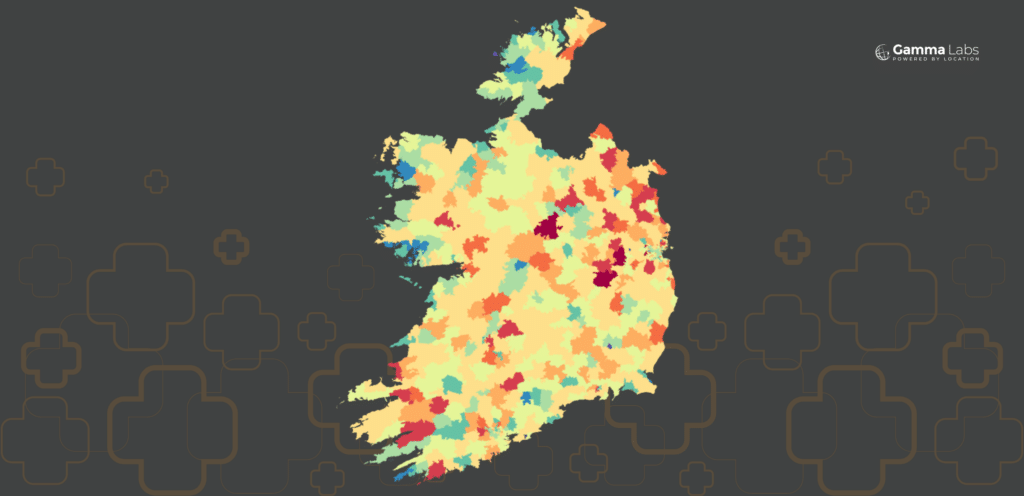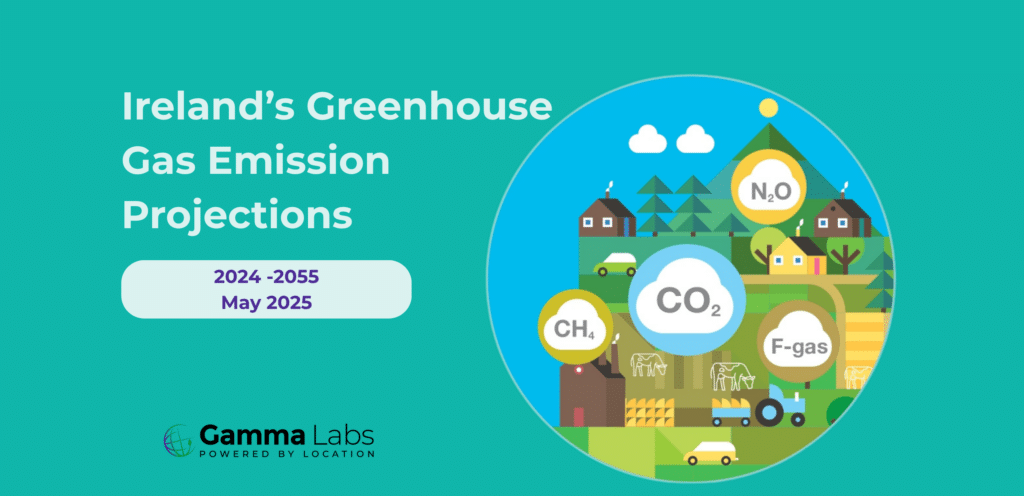Navigating Climate Change Risks in Property Insurance: GeoInsurance Ireland 2023
Current Climate Change Risks on Property & Predictive Insights
KEY TAKEAWAYS:
- An overview on how the public sector – specifically Dublin City Council – is responding and adapting to climate-related risk.
- Measuring, monitoring, and managing transitional risk.
- Identifying and mapping physical risk.
GeoInsurance 2023: Setting the Scene
Our knowledge of climate change is evolving all the time.
And along the way it is bringing new requirements for property-level data and models to enable insurers of all sizes to better assess changing peril risks and climate impacts.
So, what can insurers do in Ireland to address this challenge?
Trusted Solutions for Now & Tomorrow
Richard Garry of Gamma Location Intelligence hosted our 2023 GeoInsurance webinar opened by providing an overview of the business and its experience in supporting asset owners and investors – especially those within Insurance, Banking, and Lending – to utilise climate-related data and insights to make better informed decisions. Now and into the future.
In practice, Gamma Location Intelligence provide solutions to insurers and banking organisations that include geocoding and peril data (including flood, subsidence, crime, and fire), as well as projecting those datasets forward to consider climate change. As a companion product, Gamma also provides additional property-level attribute information within AddressLink.
Alongside these is the BERWoW solution* that enables the financial appraisal of residential properties with respect to retrofit, the associated investment required, and incentives to achieve improvements in energy efficiency.
Fundamentally, the accurate positioning of where a property or location at risk is and then overlaying adding information related to that location – be it peril or attribute data.
This – not so – dirty old town
Having opened the 5th annual GeoInsurance event, we introduced the delegates to Dr Sabrina Dekker of Dublin City Council (DCC), who kindly provided an overview of how the council is responding and adapting to climate-related risk.
The Climate Action Plan (CAP) for Dublin City was recently launched outlining its response to the Climate-Action and Low-carbon Action Development Act 2021.
The CAP outlines the objectives that DCC aims to put into place to:
- Reduce carbon emissions by 51% by 2030 (and climate-neutrality by 2050),
- To become resilient to climate risk in the future, and
- How – collectively – all parties aim to achieve resilience equitably across citizens and communities.
As a European council there is also alignment with the EU mission whereby cities across Europe are targeting carbon-neutrality by 2030. Cities in Europe have some of the highest levels of emissions globally in terms of production and consumption. As such, the objective is to both reduce emissions and prepare for adaptation.
Bringing the conversation back to local communities, Dr Dekker outlined the four foundations of the CAP:
- Social Housing
- Public Buildings
- Critical Infrastructure
- Food Strategy
All working collaboratively to reduce consumption, improve efficiency and sustainability, and improve resilience and production – from energy through to food production and health.
All of these are inter-connected.
As part of the initiative is the Resource-Full City project. Dublin is uniquely served by access to rural environments. Alongside evolving community, knowledge, innovation, and decarbonisation activities that are encompassed by the Creative City project.
Iterative, ongoing processes aimed at making a difference.
The final piece of the jigsaw is the Social City project that enables citizens to access and travel efficiency through active travel networks. Convenience and accessibility are central themes – enabling communities to live and play within the green areas that the city continues to offer.
Of course, nothing is achieved without the support of others.
Implementation requires collaboration between multiple parties – delivering on climate action. And ensuring a city that is fit for the future.
Two sides of the same coin
Building on the theme of emissions, Gamma’s Head of Spatial Analytics Richard Cantwell took charge and overviewed the complexity that is measuring, monitoring, and managing the impact of transition risk on the built environment.
Whilst physical risks are impacting our homes and where we live, we must also remember that our homes are impacting the environment in terms of transitional risk. In fact, as much as 30% of all emissions come from the buildings we live and work in.
This dual-impact is often referred to as “double materiality” – how external risk impacts us (outside-in) and how assets impact the environment (inside-out).
This is key for the insurance sector to be aware of – both in terms of underwriting and property investment – especially in relation to regulatory changes. At present, the primary area of focus is with respect to greenhouse gas (GHG) emissions across the portfolio, but this is set to evolve further.
Climate + Nature = Increased Complexity
The Task Force on Climate-related Financial Disclosures (TCFD) highlights wide-ranging recommendations – although ultimately the ability to transition, mitigate and manage certain risks is hugely challenging.
A further complication to this will be the implementation of recommendation relating to nature – the Task Force on Nature-related Financial Disclosures (TNFD) – and the need to report on these for regulatory purposes.
And It’s Not Just for Large Organisations…
Whilst the above provide disclosures guidance, it is the various regulations – such as the EU Taxonomy and Corporate Sustainability Reporting Directive (CSRD) – that have come into force that business of all sizes need to aware of and acting upon.
To date, these have generally impacted listed businesses. However, the inevitable “trickle down” to smaller organisations will happen between now and 2026.
It’s been said before, but…
“… the perceived wisdom is that starting sooner rather than later is advised”.
But What Does That Mean in Practical Terms…?
Emissions monitoring is central. Understanding and measuring scope 1, 2 and 3 emissions is key.
These are often referred to as “what you burn” (scope 1), “what you buy” (scope 2), and “what’s beyond that” (scope 3 – upstream and downstream activities).
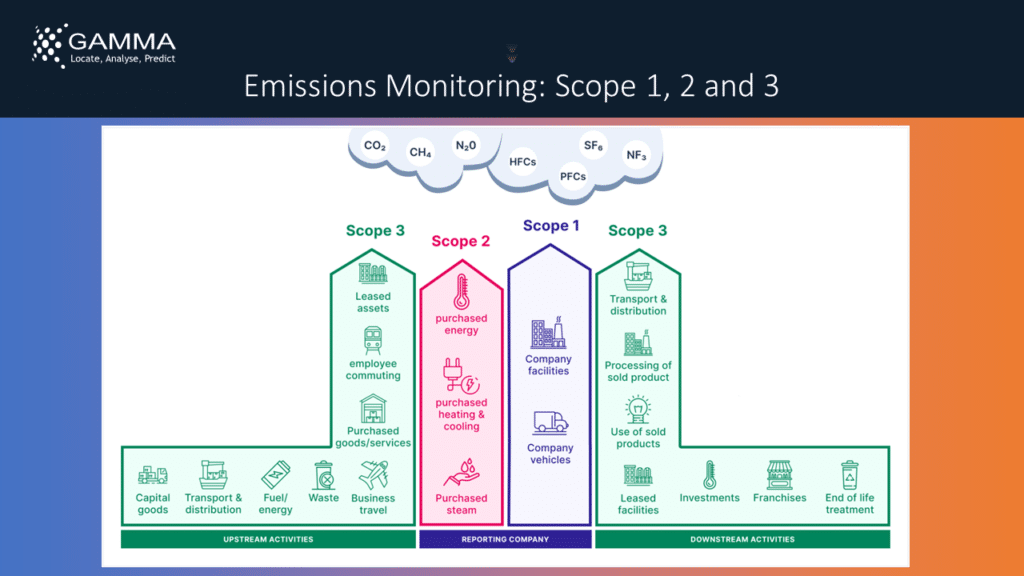
Slide Image 1: Emissions monitoring for Scope 1, 2 and 3
Of course, there is a wealth of practical advice, but the Partnership for Carbon Accounting Financials (PCAF) provides sector specific frameworks for reporting – of which insurance is highlighted.
As we are all consciously aware, there are significant undertakings required by us all to achieve targets of reducing emissions by 2030 and beyond.
In Ireland alone, around a quarter of the housing stock requires some form of mitigation in order to achieve efficiency rates of B2 and above by the 2030 timeframe. And of course, for financial institutions – whether you are insuring, mortgaging, or investing in a property – there is an element of responsibility in the enablement of these emissions if reparations are not undertaken.
It’s A Challenge, But Not Impossible
That said, knowing your exposure and the opportunity to appropriately advise and/or avoid poor emissions assets requires the ability to identify stock within your portfolio. Only then can reparations be advised and improvements to your portfolio seen.
We at Gamma can help you with this – Whether your portfolio is limited to Ireland or includes stock within the UK too.

Slide Image 2: Data Key Challenges
IDENTIFYING AND MAPPING PHYSICAL RISK
To finish off the routine, we heard from Gamma’s Chief Data Scientist, Charlotte Cuffe.
Day-to-day, Charlotte’s focus is on property data, machine learning and predictive modelling. As such, the session was a whistle-stop tour through the use and development of statistical models to help manage risk – specifically those that address physical risk and the impact of climate-change on properties.
To set the scene, we looked at what the broad predictions are in terms of climate change for the region within which these islands reside. Ireland – alongside the UK – is grouped by the IPCC (the Intergovernmental Panel on Climate Change) as part of the Northern Europe region.
In summary the impact of climate change will mean that the region will experience…
- Warmer, wetter, and more variable climatic conditions…
- Fewer droughts, but more heat,
- Less wind but more windstorms, and
- Generally, more water everywhere.
It’s Getting Hot in Here
Fewer droughts, but more heat equates to a great susceptibility to wildfire – evidenced by the image below, Southern Europe tends to have a greater exposure to wildfire, but these islands have certain areas that are far from immune.
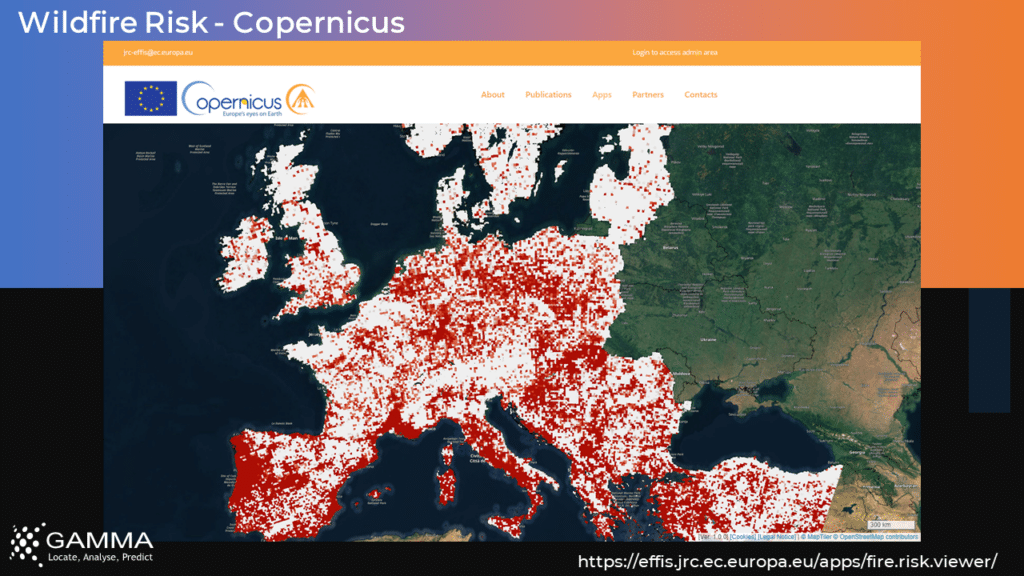
Slide Image 3: Map View of Wildfire Risk in Ireland
There are still relatively significant areas – especially those that occur in the rural-urban interface – where wildfire can have a devasting impact on life, livelihoods, and property.
Who Blew the House Down…?
This potentially provides a counter-intuitive view of climate-impact weather events. Wind speed is likely to decline, but the severity of windstorm is predicted to increase.
Whilst that might feel like it balances out, the potential for more severe – and frequent – windstorms are likely to result in an up-tick in wind-related damage.
Water, Water, Everywhere…
Rain and flood are predicted to deliver more frequent fluvial and pluvial flooding, alongside more severe flood events when they happen. As such, climate-related impacts are seen in terms of both frequency and severity.
And specifically in terms of severity, this is likely to be in terms of both the extent of the flood water, as well as the depth.

Slide Image 4: The increasing impact of flood depths – 75 Year Return Period

Slide Image 5: The increasing impact of flood depths – 100 Year Return Period
The ability to deliver a model that has a higher level of performance in predicting future exposure – and for dynamic and growing perils – is quite exciting.
(Better still) Enabling that through Perilfinder will better equip decision making around both current and future exposure at the asset (or property) level – which is key for businesses to understand when taking on risk.
Whilst the illustrations above depict the extent and depth of relative rare events that we see today, it is predicted that these types of events will become more commonplace.
Consequently, these events will inflict more damage due to the volume and depth of flooding.
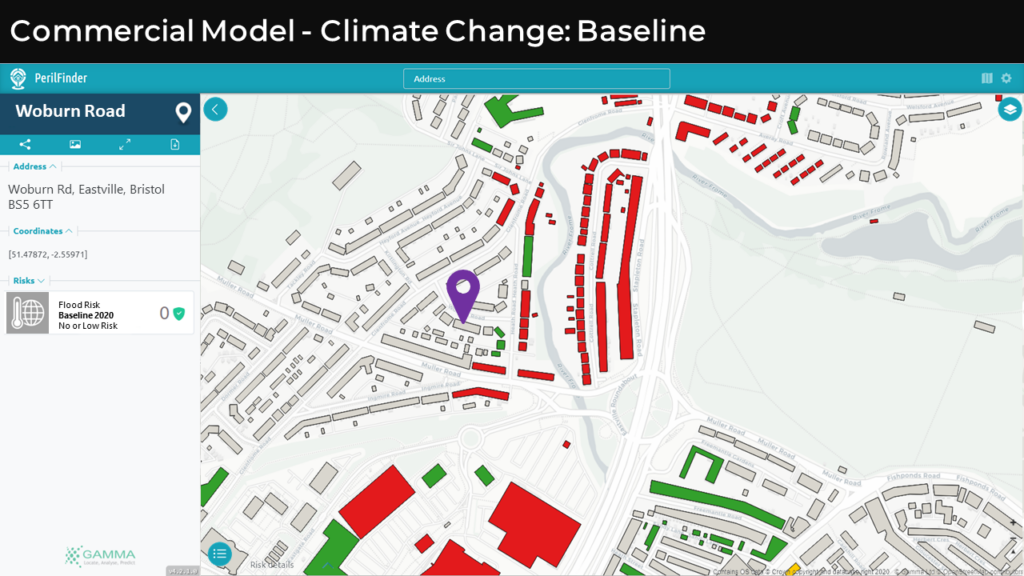
Slide Image 6: Illustrative view of property impacted by climate-related flood risk – Baseline
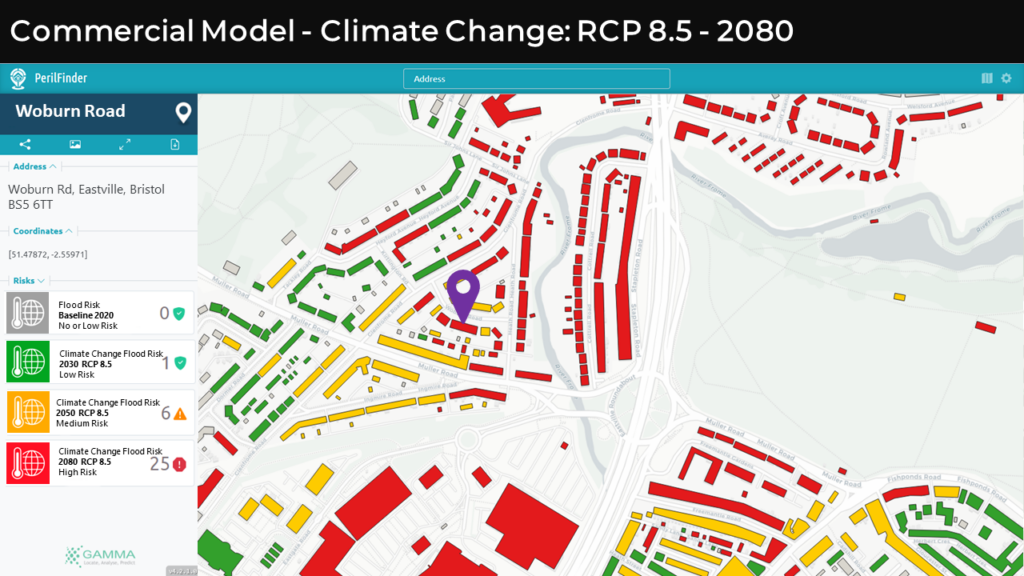
Slide Image 7: Illustrative view of property impacted by climate-related flood risk by 2080
HAZARD, EXPOSURE AND VULNERABILITY
Whilst physical risk models and associated data are foundational, the key is in being able to identify which specific properties have the greatest vulnerability and to what extent.
Coupling these models with property attribute data and rebuild estimates it is possible to gain a consistent view of what the current – and future, climate-related impact – risk to a property exists.
Delivering that intelligence at the point of need—when a decision must be made—is what Gamma LI has been supporting clients with for three decades.
Talk to us. We are not just on your side… we are by your side.
@ 2023 Gamma.ie by Jason Day
About Gamma Location Intelligence
Gamma Location Intelligence is a cloud hosted spatial solutions provider that integrates software, data and services to help our clients reduce risk through location intelligence. Established in Dublin, Ireland in 1993, and with offices in Manchester, UK and Bilbao, Spain, the company has expanded to become a global provider of innovative, cloud-hosted location intelligence solutions. Gamma Location Intelligence’s Perilfinder™ risk mapping platform provides property underwriters with access to trusted property-level risk data easily, quickly and accurately.
